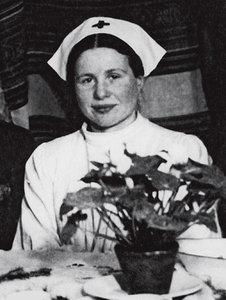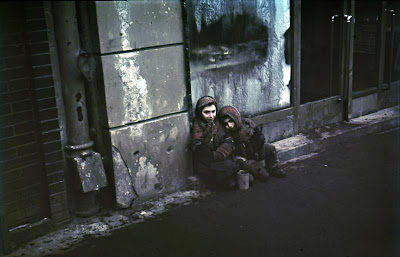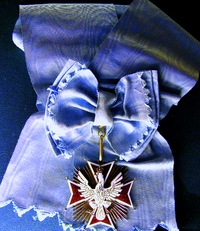 |
| Irene Sendler |
Irena Sendler (née Krzyżanowska, AKA in Poland Irena
Sendlerowa, Nom de guerre Jolanta)
15
February 1910 – 12 May 2008
In a letter to the Polish Government, Irena said: “Every child saved with my help is the justification of my existence on this Earth, and not a title to glory”
Irene Sendler was a Polish Catholic social worker who served in
the Polish Underground and the Żegota resistance organization in
German-occupied Warsaw during World War II.
As early as 1939, when the Germans invaded Poland, she began
aiding Jews. She and her helpers created over 3,000 false
documents to help Jewish families, prior to joining the organized Żegota
resistance and the children's division.
| Nazi German poster in German and Polish (Warsaw, 1942) threatening death to any Pole who aided Jews |
Helping Jews was very risky—in German-occupied
Poland, all household members risked death if they were found to be hiding
Jews, a more severe punishment than in other occupied European countries.
In August 1943, Żegota (the Council to Aid Jews) nominated
her (by her cover name Jolanta to head its children's section.
Irena, got permission to work in the Warsaw ghetto, as a
Plumbing/Sewer specialist
She had an ulterior
motive.
 |
| Irene Sendler in uniform |
As an employee of the
Social Welfare Department, she had a special permit to enter the Warsaw Ghetto
to check for signs of typhus, something the Nazis feared would spread beyond
the Ghetto. During these visits, she
wore a Star of David as a sign of solidarity with the Jewish people and so as
not to call attention to herself.
"Irena knew she had to help the sick and starving Jews who were imprisoned in the Warsaw Ghetto. She began by smuggling food, clothing, and medicine into the ghetto, then turned to smuggling children out of the ghetto." (except from Irena's Jars of Secrets by Marcia Vaughn and Ron Mazellan)
She cooperated with others in Warsaw's Municipal Social
Services department, and the RGO (Central Welfare Council), a Polish relief
organization that was tolerated under German supervision. She and her co-workers organized the
smuggling of Jewish children out of the Ghetto.
 |
| Rescued Jewish baby from Ghetto |
Under the pretext of conducting inspections of sanitary
conditions during a typhus outbreak, Sendler and her co-workers visited the
Ghetto and smuggled out babies and small children in ambulances and trams,
sometimes disguising them as packages. Irena
also smuggled Jewish infants out in the bottom of the tool box she
carried. She also carried a burlap sack
in the back of her truck, for larger kids.
Irena kept a dog in the back that she trained to bark when the Nazi
soldiers let her in and out of the ghetto.
The soldiers, of course, wanted nothing to do with the dog and the
barking covered the kids/infants noises.
 |
| Children in Warsaw Ghetto |
Assisted by some two dozen other Żegota members, Sendler
smuggled 2,500 Jewish children out of the Warsaw Ghetto and then provided them
with false identity documents and with housing outside the Ghetto, thereby
saving those children from being killed in the Holocaust. She rescued the Jewish children in different
education and care facilities for children in Anin, Białołęka, Chotomów,
Międzylesie, Płudy, Sejny, Vilnius and others.
She also used the old courthouse at the edge of the Warsaw Ghetto (still
standing) as one of the main routes for smuggling out children.
The children were placed with Polish families, the Warsaw
orphanage of the Sisters of the Family of Mary, or Roman Catholic convents such
as the Little Sister Servants of the Blessed Virgin Mary Conceived
Immaculate[11] at Turkowice and Chotomów. Sendler cooperated very closely with
social worker and catholic nun, mother provincial of Franciscan Sisters of the
Family of Mary - Matylda Getter. Some children were smuggled to priests in
parish rectories.
She and her co-workers buried lists of the hidden children
in jars in order to keep track of their original and new identities. Żegota
assured the children that, when the war was over, they would be returned to
Jewish relatives.
The Nazis eventually discovered her activities, tortured
her, and sentenced her to death (the Nazi's broke both of her legs and arms and
beat her severely); but Żegota saved her by bribing German guards on the way to her
execution. She was listed on public
bulletin boards as among those executed.
For the remainder of the war, she lived in
hiding, but continued her work for the Jewish children.
 |
| Jewish children imprisoned by the Nazis |
After the war, she and her co-workers gathered together all
of their records with the names and locations of the hidden Jewish children and
gave them to their Zegota colleague Adolf Berman and his employees at the
Central Committee of Polish Jews. However, almost all of their parents had been
killed at the Treblinka extermination camp or had otherwise gone missing.
Later at the Soviet takeover of Poland, Irena Sendler was
persecuted by the communist Polish state authorities for her relations with the
Polish government in exile and with the Home Army. During this period she miscarried her second
child.
"Motivated by conscience and armed with compassion and a belief in human dignity, Irena Sendler confronted an enormous moral challenge and proved to the world that an ordinary person can accomplish deeds of extraordinary courage." (except from Irena's Jars of Secrets by Marcia Vaughn and Ron Mazellan)
Awards and Recognition she
received after the War
The Commander's Cross by the Israeli Institute. Only in that year did the Polish communist government allow her to travel abroad, to receive the award in Israel.
In 2003, Pope
John Paul II sent Sendler a personal
letter praising her wartime efforts.
 |
| Order of the White Eagle |
On 10 October 2003 she received the Order of the White Eagle,
Poland's highest civilian decoration
As well in 2003, the Jan Karski Award "For Courage and
Heart," given by the American Center of Polish Culture in
Washington, D.C..
She was also awarded the Commander's Cross with Star of
the Order of Polonia Restituta (November 7, 2001).
On 14 March 2007, Sendler was honored by Poland's Senate. At age 97, she was unable to leave her
nursing home to receive the honor, but she sent a statement through Elżbieta
Ficowska, whom Sendler had helped to save as an infant.
 |
| 2009 Polish commemorative coin |
Polish President Lech Kaczyński stated she "can justly be
nominated for the Nobel Peace Prize" (though nominations are supposed to
be kept secret). She was nominated for
(but did not win) the 2007 Nobel Peace Prize.
On 11 April 2007, she
received the Order of the Smile as the oldest recipient of the award.
She appears on a silver 2009 Polish commemorative coin honoring some of
the Holocaust-resisters of Poland.
In May 2009, Irena
Sendler was posthumously granted the Audrey Hepburn Humanitarian Award. The award, named in honor of the late actress
and UNICEF ambassador, is presented to persons and organizations recognised for
helping children. In its citation, the
Audrey Hepburn Foundation recalled Irena Sendler's heroic efforts that saved
2,500 Jewish children during the German occupation of Poland in World War II.
 |
| Mariusz Kubik photo of Irene Sendler with some poeple she saved as children |
Sendler was the last
survivor of the Children's Section of the Żegota Council to Assist Jews, which
she had headed from August 1943 until the end of the war.
 |
| Irene Sendler age 97 |
Irena Sendler died in Warsaw on May
12, 2008.
Excerpts are from: http://en.wikipedia.org/wiki/Irena_Sendler
See more information about this astonishing woman at this
site as well…
Videos about Irena Sendler and her courageous efforts can be seen on YOUTUBE at

No comments:
Post a Comment